No. 9:
50th anniversary of PSYCHO
and
Bernard Herrmann's film score
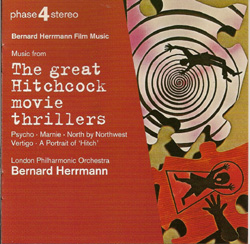
This entry is also posted at the
Science Fiction and Fantasy Web Magazine
The Thunder Child
Also mentioned on their blog
Daily Space
The Film and The Score
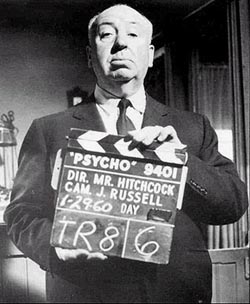
Release date for PSYCHO: June 16, 1960.
Earnings: $11, 200,000 (the top grossing film directed by Alfred Hitchcock)
PSYCHO listed on The New York Times Ten Best Films of 1960.
One of Five Best Movies of the 1960s
selected by two unlikely viewers: Elizabeth Taylor and Richard Burton
SOURCE for information: FILM FACTS by Cobbett Steinberg (1980)
Recognitions:
Oscar nomination - Alfred Hitchcock for Best Director
Oscar nomination - Janet Leigh for Best Supporting Actress
Oscar nomination - John L. Russell for Best B & W Cinematography
Oscar nomination
- Joseph Hurley, Robert Clatworthy, George Milo
for
Best Art Direction-Set Direction
Golden Globe Award - Janet Leigh for Best Supporting Actress
Writers Guild Award - Joseph Stefano for Best
Written American Drama
American Film Institute - 100 Years...100 Movies
(PSYCHO No. 18 in 1998)
American Film Institute - 100 Years...100 Thrills (PSYCHO No. 1 in 2001)

PSYCHO: Shock 'Em and Sock 'Em
Rather than discussing all of the psychological elements in this popular film, I want to tell my experience of watching this Hitchcock classic when it was first shown in movie theaters and how the music was used so effectively.
The Premiere Showing
It was in June of 1960 and I had just graduated high school so I was floating on a cloud of teenage euphoria. I had noticed the clever promo TV trailer by Alfred Hitchcock for his latest film and I was intrigued when he said that nobody should tell the film's story to their friends. Since I couldn't interest my best friend to see it with me, I went alone to the Paramount Theater, an enormous movie palace in downtown Newark, New Jersey.
Warning...if you have not seen PSYCHO, there are spoilers ahead!!
Naughty Marion
I was immediately interested when the film opened with Marion Crane (Janet Leigh) in a white bra and slip kissing a bare chested Sam Loomis (John Gavin) on a bed. That was really daring stuff for those conservative times and how it got past the censors is a mystery to me. It was reported that bra sales increased dramatically after that scene with the beautiful and buxom Janet Leigh.
L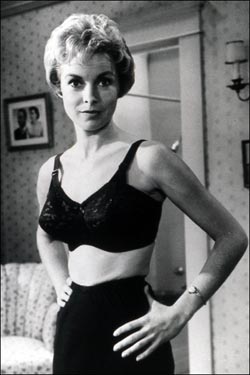 ater on in the film Marion took off with 40,000 dollars of stolen cash and
ater on in the film Marion took off with 40,000 dollars of stolen cash and
for that she was shown as the "naughty girl" dressed in black bra and slip. She had gone from the good girl in love (white) to a bad one in theft (black) and both were illustrated by what color underwear she wore! Who would have thought of that but Hitchcock? And what a lovely sight she was for a teenage guy sitting in the theater. Obviously, I wasn't paying much attention to the music in those scenes!
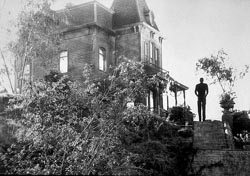
Nutty Norman
But I was aware the music was rather somber to fit Marion's guilt over stealing the money. There is a long scene when Marion talks with Norman Bates (Anthony Perkins) at the Bates Motel and he reveals himself to be a very strange though likable young man who lives in a big eerie house on top of the hill. He stuffs birds and acts somewhat like a bird as he pecks at candy corn, and he loves his mother who he says mistreats him but she is "ill." Marion feels sorry for Norman and because of their talk decides to drive home in the morning and return the money. After their conversation, she retires to her room in Cabin No. 1, and then comes the most famous moment in the film...

The Shower Scene/ The Knife
First there was Marion throwing her ripped up paper into a toilet -- reportedly shown for the first time in a Hollywood film. When Marion first steps into the shower there is no music heard. Everything seems normal until a shadowy figure appears behind her and suddenly the shower curtain is pulled back and there is the sound of high-pitched bird-like "shrieking strings." This cue was known as "The Knife" in Herrmann's score. Marion screams and the strings accompany her blood-curdling screams. This music came across like a bolt of lightning because it was so unexpected and some in the audience actually jumped in their seats when the knife starts cutting up poor Marion Crane. Then something happened I'll never forget -- several women in the audience were screaming at the top of their lungs and holding their stomachs as if somebody punched them or maybe they were ready to throw up as they quickly ran out of the theater. These were adult women, not teenage kids like at today's scary films. Most of the audience was made up of older folks -- at least older than me -- so to hear them screaming was quite a shock to me and added more fear to the murder being shown so gruesomely on screen. It was total hysteria in that theater when this famous shower scene took place.
Everyone who saw it then believed that Marion Crane was getting sliced up in that shower. And wasn't she (Janet Leigh) one of the film's stars? I actually heard one of the women say to her friend sitting behind me, "How could it be that a star gets killed like that? Well it did happen and Hitchcock deserves much credit for keeping it a secret until the film was released. Unfortunately, this scene has become so familiar that the thrill of surprise is no longer there but the music has remained just as effective in scaring the daylights out of many people.
In my book, A GUIDE TO FILM MUSIC, this is what I wrote about it:
One of the most innovative and imitated scores was composed by Bernard Herrmann for Hitchcock's classic thriller, PSYCHO. The use of strings for what Fred Steiner called Herrmann's 'black and white music.' It was unheard of at that time. Incredibly, Herrmann's score was not nominated for an Oscar.
And which score did win the Oscar for Best Film Score?
It was EXODUS, a good score, but hardly as trend-setting as Herrmann's memorable PSYCHO score, which is much more than just those "shrieking strings" in the murder scenes. The rest of the score, using only strings, is just as effective in setting the moods and raising the suspense levels of various scenes and the score fully deserved to win an Oscar, or at least be nominated.
The Legacy
On this 50th anniversary of the film and score, what should be remembered is that when it was first shown in theaters, the audiences experienced a tremendous thrill of surprise and shock.
A great deal of credit -- Hitchcock said it at least a third of the success -- was due to Bernard Herrmann's music. This thriller had a well written screenplay by Joseph Stefano (Writers Guild Award), based on Robert Bloch's 1959 novel of the same name which is more graphically gruesome and based on a real person, Ed Gein from Wisconsin, who murdered several women and attempted to dress like his dead mother.
The film has excellent acting by all, but especially from Janet Leigh, Vera Miles (Marion's sister Lila Crane), Anthony Perkins (his best ever film role) and Martin Balsam (playing the investigator, Milton Arbogast).
But probably the best remembered things about this film are the three knife scenes planned so effectively by Alfred Hitchcock and the chilling film score by Bernard Herrmann with those "shrieking strings."
For me, watching this film the first time was like taking a wild roller coaster ride at an amusement park and going up those steep inclines and then down quickly with the wind hitting you in the face -- like someone suddenly punched you.
Or to put it another way --
PSYCHO was full of shock 'em and sock 'em moments from two masters of movie suspense: Hitchcock and Herrmann.
Love it or not, this is still the best movie thriller ever made.
-- Roger Hall, June 2010
The Soundtrack
Because of the enormous appeal of this Hitchcock classic suspense thriller,
there are many CDs with music from this film, either the complete soundtrack or a suite (PSYCHO: A Narrative For Orchestra).
Here are three of the best:
Conducted by Bernard Herrmann...

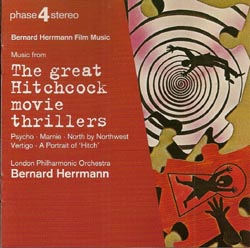
Conducted by Joel McNeely...
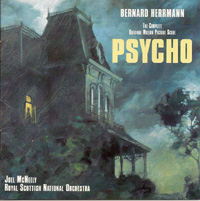
 Film In Focus
Film In Focus
See the list of significant films and music scores
from the great films of the past (1930s-1960s)
click here
